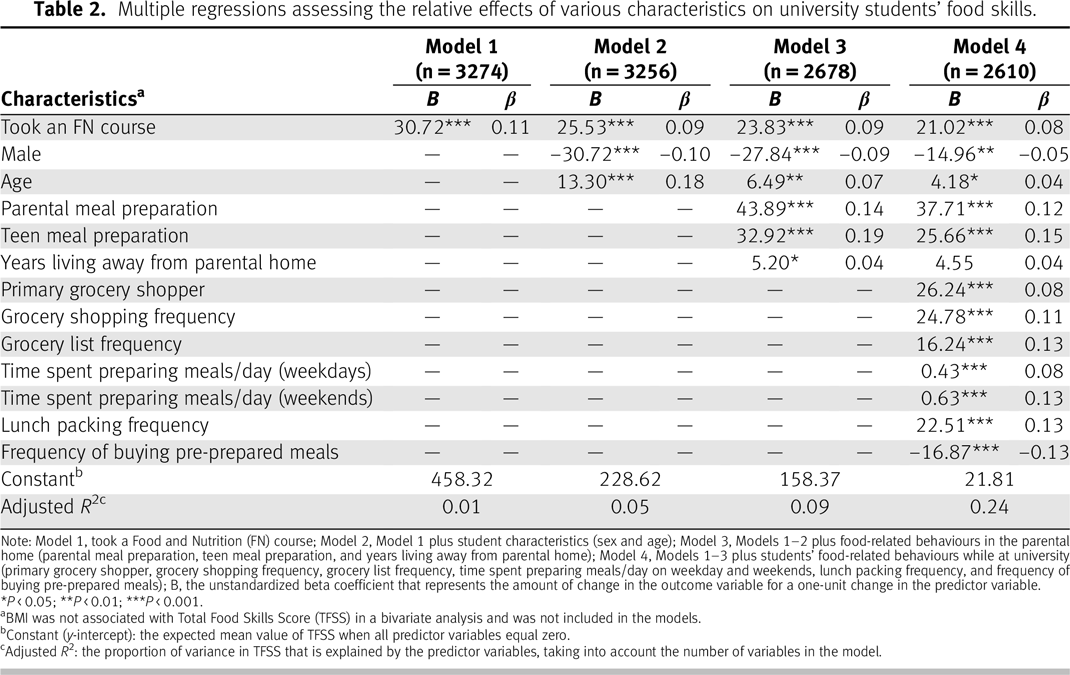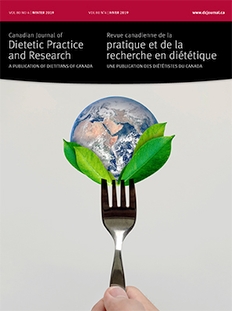INTRODUCTION
The processes involved in personal food production (e.g., planning, budgeting, shopping, preparing, storing, and cleaning up) can be overwhelming for university students with little experience in completing these tasks [
1]. Indeed, many prepare meals less than once per week [
2]. Small qualitative studies have found that minimal hands-on food participation while growing up may contribute to this situation [
3], and that few students get into the habit of checking current food stocks, making shopping lists, and grocery shopping [
4]. This is unfortunate, as the use of a grocery list has been associated with a healthier diet and lower body mass index (BMI) [
5] and higher consumption of fruits and vegetables [
6].
Having a parent who modelled food preparation was a motivator for some university students to engage in home food preparation [
7]. Practicing food-related skills as a teenager has also been associated with self-reported cooking skills as an adult [
8]. Furthermore, university students who have taken a food and nutrition (FN) course were significantly more likely to report increased self-efficacy for food skills [
2] and higher intentions toward, and greater confidence in, eating healthfully, especially when under stress [
9]. The objective of this large, cross-sectional survey was to determine the predictors of food skills in university students while simultaneously including the relative effects of FN education and student characteristics as well as food-related behaviours in the parental home and in university.
METHODS
All undergraduate students at Western University (n = 30 310) in London, Canada, were invited to complete an original online survey that assessed self-reported FN knowledge, skills, intentions, and behaviours [
9]; all are well-known aspects of Social Cognitive Theory [
10]. Students were invited to participate in a draw for 1 of 6 $100 gift cards. The Non-Medical Research Ethics Board at Western University approved the study.
The survey consisted of 67 items, 7 of which explored food skills that are relevant for young adults (
Supplementary Table 11). Students rated their food skills on a scale from 0 to 100, with higher scores indicating higher proficiency. A Total Food Skills Score (TFSS) was obtained for each respondent, with a maximum score of 700. Earlier results reported food skills by sub-groups, without determining which factors were the greatest predictors [
2]. The current study examined how much variance in food skills was uniquely associated with selected predictor variables (
Supplementary Table 21).
Data were analyzed using IBM SPSS Statistics, version 23.0 (IBM Corp., Armonk, NY, 2012). Continuous variables were described as means and standard deviations; percentages summarized categorical variables. All variables that had a statistically significant relationship with TFSS (P < 0.05) were entered in a multiple regression model with TFSS as the outcome variable. BMI was not associated with TFSS and was not included in the regression analyses. The predictor variables were conceptualized and analyzed hierarchically in regression models.
RESULTS
In total, 6638 undergraduate students completed the survey (response rate: 22%). Once students living in residence or with parents/family were excluded, the sample consisted of 3354 students who had been living independently for 2.6 ± 1.1 years (
Table 1).
In Model 1, students who had taken an FN course had significantly higher food skills than those who had not (
P < 0.001), and this relationship remained statistically significant throughout all models (
Table 2). The results indicated that the predicted TFSS of university students who had taken an FN course would be 30.72 points (out of 700) higher than the TFSS of students who had not. Only 1% of the variance in food skills was explained by an FN course alone.
In Model 2, age was positively associated with food skills (P < 0.001), and males reported significantly lower food skills than females (P < 0.001). The standardized β for age (0.18) revealed that age had a larger relative influence on food skills than sex or FN course and, collectively, these 3 variables explained 5% of the variance in food skills.
When the parental home was considered in Model 3, age, FN course, and female sex remained positively associated with food skills. Parental meal preparation, teen meal preparation, and years away from the parental home were also positively associated with food skills. Preparation of meals as a teenager was the strongest predictor of food skills. Model 3 explained 9% of the variability in food skills.
In Model 4, food skills were positively correlated with a student being the primary grocery shopper, grocery shopping frequency, grocery list frequency, weekday and weekend meal preparation, and frequency of packing a lunch (P < 0.001). Frequency of buying pre-prepared meals was negatively associated with food skills (P < 0.001). Age remained positively related to food skills (P < 0.05), although its relative contribution was much lower than in Model 2. Meal preparation as a teenager was the best predictor of food skills (standardized β = 0.15; P < 0.001). Model 4 explained 24% of the variance in food skills.
DISCUSSION
This is the largest study showing the strongest single predictor of food skills in young adults is meal preparation as a teenager. This confirms others’ conclusions about the importance of learning cooking/food skills early [
8,
11]. Similarly, university students who participated regularly in food-related activities in their parental home described themselves as having a high level of food literacy [
3,
7].
Another important finding was that having taken an FN course remained a significant predictor of students’ TFSS across all 4 regression models, suggesting that FN education should occur well before young adults begin living independently [
12–
16]. Our finding of females having higher food skills than males is also consistent with previous research [
11,
17].
Two strengths of this study were the large sample size and the incorporation of several predictors of food skills into hierarchical regression models, which allows determination of the relative importance of predictor variables simultaneously. A limitation is the sample included a higher percentage of females (73.8%) than was representative of the student population (i.e., 55% female) [
18]. The cross-sectional design prevented determination of causal mechanisms. Recall bias may also be a limitation.





